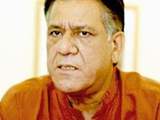Konkona Sensharma: Dying to tell the tale
Konkona Sensharma on adapting her father's story and working with Om Puri on A Death In The Gunj'
The first film Konkona Sensharma directed was Naamkaran, a 2006 short about a family with an unconventional talent. It was a modest film, bare-bones in appearance but with a wonderful tart tone and a sting in its tail. The stylistic jump from this to Sensharma's controlled, vividly realized debut full-length feature, A Death In The Gunj, is considerable. Still, the idea of a close-knit groupnot a family, maybe, but a "familial world, as she puts itharbouring secrets is something that links the very different worlds of the two films.
It's difficult, even with an actor as accomplished as Sensharma, not to circle back to family in conversation with her. Her mother, Aparna Sen, is a well-known actor and director of such films as 36 Chowringhee Lane and Mr And Mrs Iyer (for which Sensharma won Best Actress at the National Film Awards in 2002). Her grandfather, film critic Chidananda Dasgupta, was the co-founderwith Satyajit Ray, among othersof the Calcutta Film Society. Her father, Mukul Sharma, is a journalist and writer, and the originator of a spooky story (based partly on a real event) that Sensharma became fascinated with as a child, and which eventually became the inspiration for her first feature.
In A Death In The Gunj (releasing on 2 June), which opened last year's Mumbai Film Festival, a group of friends and relatives converge in McCluskieganj, a sleepy town in Jharkhand, to picnic, drink, play games and exorcise personal demons. Surface resemblances to Satyajit Ray's Aranyer Din Ratri (which Sensharma says are coincidental) notwithstanding, the film is an original confectionmixing memory and desire and the sort of unapologetic sideburns you could sport in 1979 with some of the best ensemble acting in any Indian film in recent years (the cast includes Kalki Koechlin, Ranvir Shorey, Tillotama Shome, Vikrant Massey, Gulshan Devaiah, Jim Sarbh, Om Puri and Tanuja). We spoke to Sensharma about making the transition from actor to writer-film-maker, and what it was like to direct Om Puri, who died earlier this year, in one of his last performances. Edited excerpts from an interview:
How old were you when you heard the story that eventually became this film?
I must have been 8 or 9. Everyone has family anecdotes from this or that tripmostly funny stories, but also some which haunt you. This was one of those. It just stayed with me over the years. When someone you love tells you a story, and they tell it well, and you hear it over and over, it becomes something else in your head. It encapsulates the era when I was born, my parents' imagined youth...
You visited McCluskieganj as a child. Did you have any memories from that time?
Before the film, the last time I was there I must have been about 7. The executive producers visited McCluskieganj before I did a location recce; they came back convinced that I'd been there recently because some of the things in my script were exactly what they found. I described things I didn't know I remembered, like the layout of the house, and that it belongs to a colonel. I wrote about this stream, and there actually was a stream there.
Did you have any of the actors in mind when you were writing?
Just two people. I knew I wanted Vikrant from the beginning; I saw him in Lootera and really liked him. And I had Ranvir in mind for the part of Vikram.
I was very lucky to get everyone else. I knew Kalki is a great actor, but I hadn't seen Jim Sarbh's work at allNeerja hadn't released at the time. He came in and did a reading and I was, like, wow. Tanuja would never have occurred to me either, but Honey Trehan (the film's producer and casting director) suggested her and she was great.
Your family seems to favour cinematographer Sirsha Ray: He's shot two films you acted in and one which your mother directed.
And he worked with my grandfather, can you believe it? He's shot for three generations in my family. I did my first film as an adult with him; it was his first film as a cinematographer as well. So we go way back.
Did you speak to him a lot regarding the film's visual aesthetic?
I meant to, but he doesn't talk very much (laughs). But he came to Bombay several times, and we discussed the film, and even when he wasn't talking, he drew things.
Did you refer to any films of the time?
Not that it's very similar, but there was this film called Picnic At Hanging Rock which had an impact on me as a child. It was a haunting film, very atmospheric, the music is so piercing and beautiful. I rewatched it with my DoP (director of photography) and production designer. There is that feeling of an old world, where something haunting happens.
A lot of comparisons have been drawn between A Death In The Gunj' and Aranyer Din Ratri'.
Now that one actually is weird. I only saw Aranyer once long ago, and I don't remember it that well. It's not like Charulata or The Apu Trilogy, which I feel a deep emotional connection with. I have heard people say that Aranyer is similar to A Deathmaybe because it's a bunch of Bengali people going on holiday? I mean, I'm happy to occupy any space with him. Ray is our heritage; I guess it has to show at some point.
What was it like to work with Om Puri?
He never seemed to take anything too seriously. He used to make fun of me all the time. I'd be all stressed when I went to him on set, and soon I'd be giggling and cajoling him to get his scene done.
He took to that place so beautifully. The bulk of us lived in Ranchi and would travel there, but somelike Sirsha and Tillotamalived in McCluskieganj. Om also ended up staying there, in someone's house. One day, we were driving from one location to another and we saw Om sitting by the side of the dirt road, drinking chai.
He never saw the final film. It wasn't ready. We'd just sent it to a couple of festivals (when he died). The last day I saw him was when he was dubbing. We were all pakao'd (exasperated) by then, but he was in such high spirits. To watch him and Tanuja banter was amazing, because she's one of those kickass bohemian women herself.
http://www.livemint.com/Leisure/YZP4jqpMeBWaY0qMqOj53M/Konkona-Sensharma-Dying-to-tell-the-tale.html



















comment:
p_commentcount